What ash trees and bumble bees are telling us
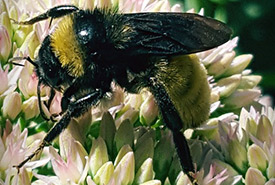
American bumble bee (Photo by K.S. Gardener/iNaturalist)
Black ash and American bumble bee are not species I thought we would ever need to save.
When I started my studies in conservation over 25 years ago, bumble bees still seemed commonplace, and I thought of ash as a common tree that was great for firewood.
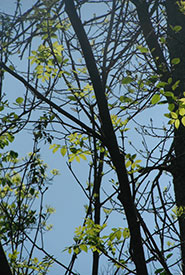
Black ash (Photo by carolinianconnor CC BY-NC)
But in just 25 years, the fate of both black ash and American bumble bee has drastically changed. Both species were recently assessed as at risk by the Committee on the Status of Endangered Wildlife in Canada. The Canadian assessment of black ash and American bumble bee reflects their global status. Both species are also on the International Union for Conservation of Nature Red List of Threatened Species.
Black ash and American bumble bee are part of a growing group of species that are rapidly declining.[1] Once common, they are now going, going, and maybe gone.
A threatening invader
Black ash is still a common tree found in swamps and is one of six native species of ash that live in Canada. Like its cousins white and red ash, it is widely distributed in in the eastern part of our country and ranges from the island of Newfoundland to Manitoba.
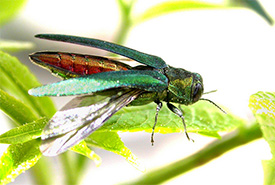
Emerald ash borer adult (Photo by by U.S. Department of Agriculture)
But black ash and its entire family are under threat in North America by the invasive emerald ash borer (EAB). No one knows the exact origin story of EAB, but in the mid-1990s wooden pallets from Asia were unloaded in Michigan. Hidden inside the wood were EAB larvae. In Asia, ash trees have evolved with EAB and have defenses against the insect, just like ash trees in North America have evolved to co-exist with many North American insects. But when the unlikely introduction was made, the EAB found a continent of ash trees with no evolutionary experience in fending off its wood-boring larva.
The decline of Canada's bumble bees
About the same time that EAB was spreading from Asian ash pallets to North American ash trees, scientists were starting to notice that something was impacting our native bumble bees. Species that had once been common and widespread were becoming rare and restricted, including American bumble bee. Today, about one-quarter of Canada’s bumble bees are now at some level of risk of being lost.
Unlike black ash, where there is a clear threat, the decline of bumble bees is probably the result of many factors. Habitat loss, competition from non-native European honey bees, introduced bee diseases and parasites, pesticides and climate change likely all have a role.
Related blog posts
Small population conservation
Conservation has long been focused on rare species. This is important work. A species with just a few remaining individuals is vulnerable to natural catastrophes, like floods, and genetic issues as a result of inbreeding. This can create an “extinction vortex”[2], where low genetic diversity reduces reproductive success, which further reduces the population. Saving these species is what scientists call small population conservation. These are the endangered species of my youth — wildlife such as whooping crane, Vancouver Island marmot and swift fox — animals with small populations and clearly teetering on the brink of extinction.
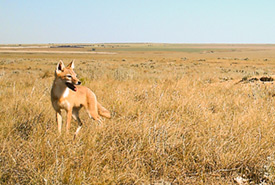
Swift fox in southern Alberta (Photo by NCC)
We have some effective tools for small population conservation. Protected areas can conserve their habitat. Zoos can breed and reintroduce new populations or increase genetic diversity. And we have some great success stories. Today we still have small populations of whooping cranes and Vancouver Island marmots thanks to focused conservation efforts. The Calgary Zoo is currently breeding endangered greater sage-grouse. Swift fox have returned to the Canadian prairies as a result of captive breeding and release, and habitat protection, including at one of the Nature Conservancy of Canada’s properties.
Declining population conservation
Calls to stop common species from declining often go unheard, and these species can even be subject to extinction denialism. When it became clear that great auks were disappearing as a result of unregulated harvest, some people said they simply moved to more northern waters.[3] When populations of passenger pigeons were spiralling downward, the Ohio Senate reported in 1857 that:
“The passenger pigeon needs no protection. Wonderfully prolific, having the vast forests of the North as breeding grounds, travelling hundreds of miles for food, it is here today, and elsewhere tomorrow, and no ordinary destruction can lessen them”.[4]
We now know that humanity excelled at the extraordinary destruction of this bird, and we sadly have many examples of common species that we’ve pushed to, and over, the brink of extinction.
It’s sometimes hard for scientists to convince people about the need for declining population conservation. About the need to keep common species common. It’s much easier to show that one of Canada’s only remaining populations of wild hyacinth on Pelee Island is threatened today than it is to gain support for protecting the rapidly declining bobolink that could be lost in a century from now.
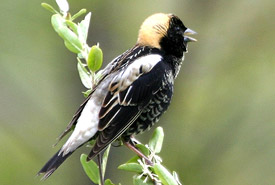
Bobolink (Photo by Bill Hubick)
Declining population conservation isn’t new. We have saved many species that were once common and then almost gone, and we need to teach and celebrate this success. But what is different now is our ability to detect declining populations earlier and the threats that are facing these species.
In the past, we only saved plains bison, pronghorn, trumpeter swan and other species when their numbers dwindled. We waited until declining population conservation became small population conservation. This is a risky strategy. In the U.S., the heath hen shrunk to a few hundred individuals, and despite 40 years of conservation efforts, went extinct in 1932.[5]
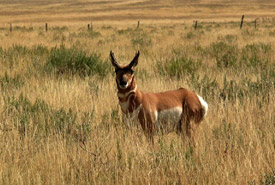
Pronghorn in Alberta (Photo courtesy of the University of Calgary)
We know it’s much better to be preventative and to not let species decline to a few precarious individuals that are vulnerable to human threats and natural events. Proactive actions to keep species from approaching extinction is ecologically and economically effective. If we had assessed and responded to the declining trend of the passenger pigeon back in 1857, we probably could have saved it.[6]
Causes of species loss in Canada
The first wave of extinction and declining wildlife populations in Canada happened because of over-hunting. Today, game laws and international treaties have changed our attitudes and practices toward game management, and overharvesting is no longer a significant issue for species conservation in North America.
Our challenge today is that many species are declining because of a multitude of complicated threats. Habitat loss, invasive species, climate change and pollution are all affecting many species, such as black ash and American bumble bee. We can solve these, but we need many solutions. We can’t just pass a law to ban emerald ash borer. Laws and legislation certainly have a key role, but they are only one ingredient in the conservation recipe we have yet to perfect.
What’s also different about species loss today is that, for the most part, we’re not even trying to kill them. There is no political agenda to wipe out the last bumble bees and no secret black market for black ash. They are declining because of unprecedented changes to the world around us. Changes to our land, our air and our water.
A new study warns that the rapid decline of insects could lead to the extinction of 40 per cent of the world’s insect species in the next few decades.[7] If current rates of decline continue, there will be half as many chimney swifts, cerulean warblers and eastern meadowlarks in less than 30 years from now.[8]
A world where common species are declining is not a sustainable world. This is their message to us.
Keeping our common species common
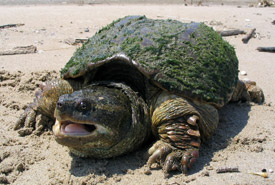
Snapping turtle (Photo by Ryan M. Bolton)
There is urgency in keeping our common species common. Wildlife is slowly slipping away from us. Brown bat, snapping turtle, wood thrush, monarch and Sprague’s pipit are species you may often witness today, but they were more common when your grandparents were young. If their slow decline continues, your children will see fewer, your grandchildren fewer yet, and they could eventually just slip away.
There is an intergeneration transfer of extinction that has been happening for a long time. Stopping this is the conservation challenge for our generation. We need to reverse habitat loss, clean our air and water, manage invasive species and ensure we have effective programs to monitor wildlife populations. Perhaps most importantly, we need to embrace the opportunity we all have today to pass on a biologically richer world to our children’s tomorrow.
Sources
1. World Wildlife Fund, Living Planet Report - 2018: Aiming Higher, M. Grooten and R. Almond, Editors. 2018, WWF: Gland, Switzerland.
2. Gilpin, M.E. and M.E. Soule´, Minimum viable populations: processes of extinction, in Conservation Biology: The Science of Scarcity and Diversity, M.E. Soule´, Editor. 1986, Sinauer Associates: Sunderland, MA. p. 19–34.
3. Mowat, F., Sea of slaughter. 1st American ed. 1984, Boston: Atlantic Monthly Press. 438 p.
4. Fuller, E., The passenger pigeon. 2014: Princeton University Press.
5. Simberloff, D. The Proximate Causes of Extinction. in Patterns and Processes in the History of Life. 1986. Berlin, Heidelberg: Springer Berlin Heidelberg.
6. Stanton, J.C. 2014. Present-day risk assessment would have predicted the extinction of the passenger pigeon (Ectopistes migratorius). Biological Conservation. 180: 11-20.
7. Sánchez-Bayo, F. and K. A. G. Wyckhuys (2019). Worldwide decline of the entomofauna: A review of its drivers. Biological Conservation 232: 8-27.
8. Partners in Flight (2017). "Avian Conservation Assessment Database, version 2017." Retrieved January 2019, from http://pif.birdconservancy.org/ACAD


